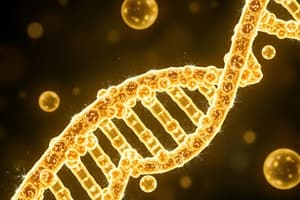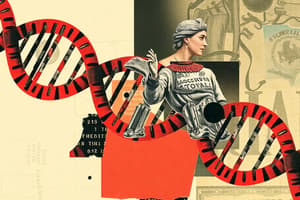Podcast
Questions and Answers
Which of the following statements about telomeres and aging is correct?
Which of the following statements about telomeres and aging is correct?
- Telomeres are unaffected by telomerase activity throughout life
- Insufficient telomerase leads to telomere shortening during aging (correct)
- Telomeres actually replicate without the need for telomerase
- Telomeres lengthen as we age due to improved telomerase activity
What is the main role of TERT in telomeric replication?
What is the main role of TERT in telomeric replication?
- To synthesize RNA from DNA
- To initiate the process of cell division
- To guide proper attachment of the enzyme (correct)
- To extend telomeres during DNA replication
What is the primary function of messenger RNA (mRNA)?
What is the primary function of messenger RNA (mRNA)?
- To form part of the ribosome structure
- To replicate DNA strands during synthesis
- To carry genetic information from DNA for protein synthesis (correct)
- To transport amino acids to the ribosome
Which nitrogenous base pair is correctly matched in RNA base pairing?
Which nitrogenous base pair is correctly matched in RNA base pairing?
Which type of RNA is primarily responsible for forming part of the ribosome?
Which type of RNA is primarily responsible for forming part of the ribosome?
What role does transfer RNA (tRNA) play in translation?
What role does transfer RNA (tRNA) play in translation?
Which statement accurately describes the genetic code?
Which statement accurately describes the genetic code?
What characteristic of the genetic code describes its redundancy?
What characteristic of the genetic code describes its redundancy?
Which of the following statements is true about the genetic code's structure?
Which of the following statements is true about the genetic code's structure?
What does the term 'colinear' refer to in the context of the genetic code?
What does the term 'colinear' refer to in the context of the genetic code?
Which DNA polymerase is responsible for the continuous synthesis on the leading strand?
Which DNA polymerase is responsible for the continuous synthesis on the leading strand?
What role does the FEN1 enzyme play during DNA replication?
What role does the FEN1 enzyme play during DNA replication?
What is the primary function of telomerase in eukaryotes?
What is the primary function of telomerase in eukaryotes?
What occurs during the polymerase switching mechanism in DNA replication?
What occurs during the polymerase switching mechanism in DNA replication?
Why can DNA Polymerase α not fill the gaps left at the 5’ ends of newly synthesized DNA?
Why can DNA Polymerase α not fill the gaps left at the 5’ ends of newly synthesized DNA?
What happens during the termination phase of DNA replication?
What happens during the termination phase of DNA replication?
What is the consequence of having no free 3’-OH groups during DNA replication?
What is the consequence of having no free 3’-OH groups during DNA replication?
Okazaki fragments are primarily associated with which strand during DNA replication?
Okazaki fragments are primarily associated with which strand during DNA replication?
What direction is the genetic code always read?
What direction is the genetic code always read?
Which of the following is a start codon in the genetic code?
Which of the following is a start codon in the genetic code?
What do exons represent in a gene?
What do exons represent in a gene?
Which sequence is NOT involved in the initiation of transcription?
Which sequence is NOT involved in the initiation of transcription?
What is the role of introns in gene expression?
What is the role of introns in gene expression?
Which of the following correctly defines the role of enhancers in transcription?
Which of the following correctly defines the role of enhancers in transcription?
What is the first step in the transcription process?
What is the first step in the transcription process?
What defines the end of a transcriptional unit?
What defines the end of a transcriptional unit?
What is the primary role of aminoacyl tRNA synthetase in translation?
What is the primary role of aminoacyl tRNA synthetase in translation?
Which site on the ribosome does the tRNA carrying the growing polypeptide chain occupy during translation?
Which site on the ribosome does the tRNA carrying the growing polypeptide chain occupy during translation?
What is the function of eukaryotic initiation factors (eIFs) during mRNA translation initiation?
What is the function of eukaryotic initiation factors (eIFs) during mRNA translation initiation?
During elongation, what occurs to the tRNA that is situated at the P site after its amino acid is added to the peptide chain?
During elongation, what occurs to the tRNA that is situated at the P site after its amino acid is added to the peptide chain?
What happens during the translocation phase of translation?
What happens during the translocation phase of translation?
Which component is involved in recognizing the start codon during translation initiation?
Which component is involved in recognizing the start codon during translation initiation?
What is a significant characteristic of ribosomes during the process of translation?
What is a significant characteristic of ribosomes during the process of translation?
What is the initial step in mRNA translation?
What is the initial step in mRNA translation?
Study Notes
Elongation in DNA Replication
- Clamp loader (RF-C) and sliding clamp (PCNA) assemble at primer-template junctions.
- Polymerase switching occurs: DNA Pol α/primase complex dissociates, replaced by DNA Pol δ or ε for extension.
- DNA polymerases synthesize DNA in a 5’ → 3’ direction, requiring a free –OH end.
- Leading strand synthesized continuously by DNA Pol δ from the 3’ → 5’ parental strand toward the replication fork.
- Lagging strand synthesized discontinuously by DNA Pol ε, forming Okazaki fragments away from the replication fork.
- FEN1 and RNaseH remove RNA primers, allowing DNA Polymerase α to fill gaps with DNA.
- DNA ligase seals the sugar-phosphate backbones between DNA fragments.
Termination of DNA Replication
- Termination occurs when replication forks converge on the same DNA stretch, signaling completion.
- Helicase and topoisomerase leave when they exhaust space to operate.
Telomeric Replication/Synthesis
- Telomeres maintain chromosomal stability, preventing degradation.
- Eukaryotic telomeres consist of short, repeated nucleotide sequences, extending through the action of telomerase.
- Telomerase includes TERC (telomerase RNA component, catalytic subunit) and TERT (telomerase reverse transcriptase, guides enzyme attachment).
- Telomeres shorten with age, leading to senescence/apoptosis due to insufficient telomerase.
Central Dogma of Molecular Biology
- Developed by Francis Crick in 1958, illustrating the flow of genetic information from DNA to RNA, resulting in protein synthesis.
RNA Overview
- RNA (Ribonucleic acid) acts as a messenger, is single-stranded, and is located in the nucleus and cytoplasm.
Types of RNA
- Messenger RNA (mRNA) carries genetic information from DNA to ribosomes.
- Ribosomal RNA (rRNA) is a component of ribosomes and aids in protein synthesis.
- Transfer RNA (tRNA) delivers amino acids to ribosomes, matching anticodons with mRNA codons during translation.
Codons and the Genetic Code
- A codon is a three-nucleotide sequence in mRNA that corresponds to a specific amino acid.
- The genetic code is composed of nucleotide triplets, is degenerate, non-overlapping, comma-less, nearly universal, collinear, and directional.
- Contains start codon (AUG, Methionine) and stop codons (UGA, UAG, UAA).
Genes and Gene Expression
- Genes are hereditary units located on chromosomes, encoding RNA or protein products.
- Transcription transfers information from DNA to RNA, utilizing RNA polymerase to synthesize mRNA.
- Key elements of a eukaryotic gene include promoter sequences, exons, introns, terminator sequences, enhancers, and silencers.
Transcription Process
- Initiation involves binding of RNA polymerase to promotor regions.
- Elongation is the synthesis of RNA based on the DNA template.
- Termination signifies the end of transcription, releasing the newly formed RNA strand.
Translation Overview
- Occurs in the cytoplasm, where mRNA is converted into a protein sequence.
- mRNA combines with ribosomes; polypeptides are synthesized as ribosomes simultaneously translate one mRNA molecule.
tRNA Charging
- Requires aminoacyl-tRNA synthetase to link tRNA with its corresponding amino acid.
Ribosome Composition
- The ribosome consists of three sites: Aminoacyl (A) site, Peptidyl (P) site, and Exit (E) site.
Steps in mRNA Translation
- Initiation includes assembly of ribosome components and binding of the initiator tRNA.
- Elongation adds amino acids to the growing polypeptide chain via peptide bonds.
- Termination concludes protein synthesis at stop codons.
Initiation Mechanism
- In eukaryotes, a cap-dependent mechanism assembles ribosomal subunits at the 5’ cap of mRNA.
- Translational initiation involves eukaryotic initiation factors stabilizing the start codon and tRNA.
Elongation Process
- Eukaryotic elongation factors transport tRNA to the ribosome; peptide bonds form between amino acids, progressing the polypeptide chain.
Studying That Suits You
Use AI to generate personalized quizzes and flashcards to suit your learning preferences.
Description
This quiz covers the elongation phase of DNA replication, focusing on key components such as the clamp loader (RF-C), sliding clamp (PCNA), and polymerase switching. Learn how DNA polymerases synthesize DNA in the 5' to 3' direction and the roles of different polymerases during this critical process.




